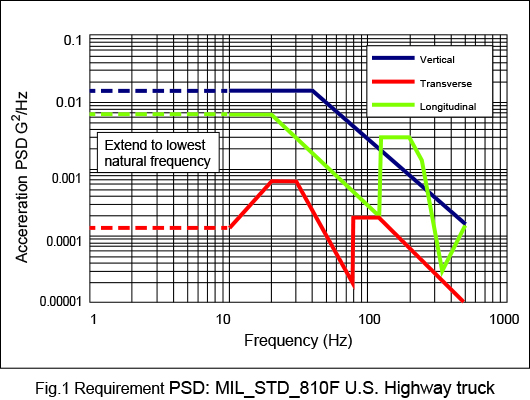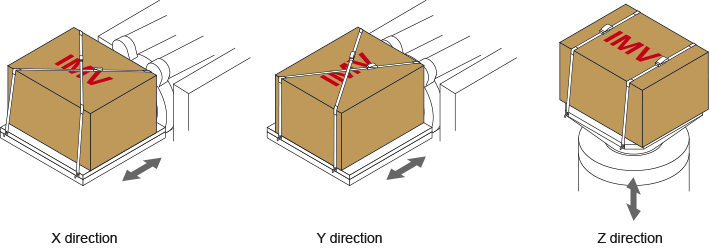Transport test 2
Vibration test assuming truck transportation with a mileage of 2000 km in cardboard packaging for export.
MIL-STD-810F, Method 514.5 Annex A 2.2.1 Category 4 a. Truck transportation over U.S. highways.
The STANDARD specifies that the test shall be carried out with a PSD extending from 10 Hz to the lowest natural frequency in the low frequency range. To verify this, the packaging must be opened and a response-measuring accelerometer fitted inside the EUT prior to this test, and vibration response measurement excitation must be carried out.
It was determined that there is no natural frequency below 2.5 Hz unless a special vibration isolation system is fitted. To save time, it was decided to extend the testing to 2.5 Hz and omit the response measurement.
For a cargo of this size, the vertical PSD was applied to the vertical direction of the EUT, as it was determined that the vertical designation of the cargo would be adhered to during transport.
The orientation of the cargo with respect to the front-back and left-right directions of the vehicle is not specified, except that the left-right PSD of the STANDARD slightly exceeds the front-back direction at around 30 Hz, so the front-back PSD was applied to both horizontal two directions of the cargo, as the front-back direction is larger at all frequencies.
The EUT is fixed by a belt. The vibration duration is 75 min in each axis (= 60 min × 2000 km/1609 km).
Test overview
■ EUT
1000 mm × 800 mm × H600 mm, 100 kg
Fig. 1 RequirementPSD: MIL_STD_810F U.S. highway truck

X-direction/Y-direction/Z-direction

Acceleration, velocity and displacement when PSD is extended to 2.5 Hz in the low frequency range

Memo
Facilities used
Vibration test system with slip table: i260/SA7M/HT10
Vibration controller: K2 software Random
Head expander: TBV-950S-i60-M, 130 kg
Test time
3 hours

